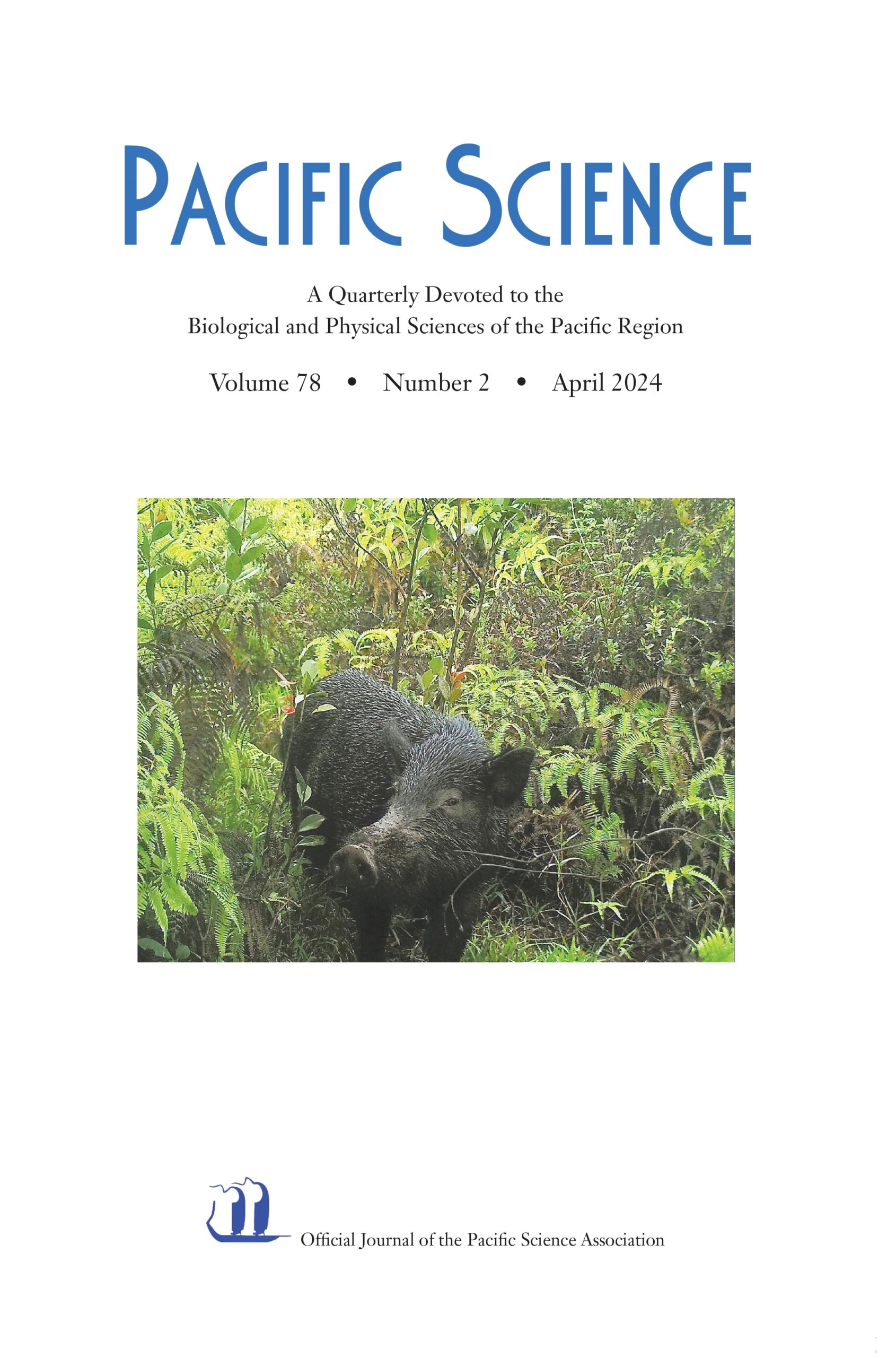Pacific Science: A Quarterly Devoted to the Biological and Physical Sciences of the Pacific Region
Individual Subscriptions
Institutional Subscriptions
Additional Information
The official journal of the Pacific Science Association. Appearing quarterly since 1947, Pacific Science is an international, multidisciplinary journal reporting research on the biological and physical sciences of the Pacific basin. It focuses on biogeography, ecology, evolution, geology and volcanology, oceanography, paleontology, and systematics. Manuscript submissions on topics such as Pacific biodiversity, conservation, and sustainability are also encouraged. In addition to publishing original research, the journal features review articles providing a synthesis of current knowledge.
Submit your manuscript online.
Sponsor: Pacific Science Association
CiteScore: 1.8 Scopus Ranking: 31/110
Impact Factor: 1.101
Journal Citation Reports® Rankings:
84/110 – Marine & Freshwater Biology
117/175 – Zoology
- Recent Articles
-
Phylogenetics Confirms a Unique Instance of Endemicity in a Polyphagous Hawaiian Moth Pest and Uncovers a Remarkable New Species
Posted on Monday January 13, 2025Genetic Composition in Populations of the Endangered Hawaiian Shrub, Schiedea adamantis St. John (Caryophyllaceae) and the Importance of Ex Situ Collections
Posted on Monday January 13, 2025A Synopsis of the Genus Jacquemontia (Convolvulaceae) in the Indo-Pacific With the Description of One New Species
Posted on Monday January 13, 2025From the Pasture to the Present: The History of Grass Introductions in Hawai‘i
Posted on Monday January 13, 2025Insights Into Ungulate Distributions Show Range Expansion, Competition, and Potential Impacts on a Sub-Tropical Island
Posted on Monday January 13, 2025Indo-Pacific Eels (Anguilla marmorata) From the Caroline Islands Belong to the Micronesia Population Based on Total Number of Vertebrae Counts
Posted on Monday January 13, 2025 - Single Issues
- Volume 71, Number 4, October 2017
- Scaling Up Restoration Efforts in the Pacific Islands
- Volume 71, Number 4, October 2017
PAYMENT
All prices are indicated in U.S. dollars. Canadian customers must include 5% GST (automatically included at checkout). All prices shown are exclusive of any taxes.
Payment must be included with all orders. We accept payment by U.S. dollar checks drawn on a U.S. bank and made payable to the University of Hawaii Press. We also accept payment by Visa or MasterCard. If paying by credit card please include the card number, expiration date, cardholder name and billing address. If you wish to pay by bank transfer, please contact us for bank details. No refunds will be made except for erroneous duplicate orders.
PRINT SUBSCRIPTIONS – GENERAL INFORMATION
Subscription Start
Print subscriptions start from the first issue of the calendar year and are effective for the entire volume year. Subscriptions may be entered retroactively. Unless otherwise requested, subscriptions will start with the current year’s volume.
Shipping / Postage
All prices shown include standard delivery in the U.S.A. Additional postage will be charged at checkout for print orders mailed outside the U.S.A. Priority Mail option at additional cost is available at checkout. Please contact customer service for other shipping options.
Single Issues / Back Issues
Single-issues of current print volumes may be ordered. Print issues older than two years are available in limited supply and may be purchased at a discounted rate. Please fill out a single-issue order form.
Bookstores/Classroom Use
Bulk-rate discounts for one-time print orders are 20% on 10-19 copies and 30% on 20 or more copies. Postage charges are NOT discountable. All sales are final, we do not accept return of journal issues. Please contact customer service to order bulk copies.
INDIVIDUAL ORDER INFORMATION
Individual rates apply to subscriptions and single issue orders for individual (personal) use. You must provide a first name, last name, and telephone number.
Online access
When you place your order for online access (electronic subscription), you will receive an emailed receipt that includes an activation code and a link to this page: https://associations.press.jhu.edu/uhp/
Please enter your activation code and register on the site to gain access to the journal content. A FAQ is available here: https://faq.press.jhu.edu/uhp
We are pleased to partner with the Johns Hopkins University Press and Project MUSE to provide online access to subscribers.
INSTITUTIONAL ORDER INFORMATION
Institutional rates apply to subscriptions and single issue orders for Institutional / Organizational use and paid for by libraries, universities, schools, societies, government offices, departments, businesses and the like. If you are ordering on behalf of your institution, please include the institution name.
Online access and Print + Online orders
Institutions may order electronic subscriptions or print + electronic through our hosting partner Project MUSE: https://muse.jhu.edu/cgi-bin/single_title_subscription.cgi?year=2017
You may contact Project MUSE at [email protected].
SUBSCRIPTION CLAIMS
Claims for non-receipt of issues will be honored at no charge within 180 days of the original ship date. Thereafter, the single copy rate will be charged for replacement. No more than one free replacement per issue will be allowed. Credits for non-receipt are not offered.
SUBSCRIPTION AGENTS
Please see our current title listing and rate sheet. We offer an agency discount of 5% off the institutional subscription rate. We do not offer discounts on single issue orders or postage. New agents must provide the URL of their business website or submit their initial correspondence on official company letterhead.
Please contact customer service at:
Journals Department, University of Hawai‘i Press, 2840 Kolowalu Street, Honolulu, HI 96822
Tel. 1-808-956-8833; Fax 1-808-988-6052
Toll-free (U.S. & Canada) Tel. 1-888-UHPRESS; Fax 1-800-650-7811
e-mail: [email protected]
Contributions to the biological and physical sciences of the Pacific area are welcomed from authors in all parts of the world. Manuscripts should be submitted online. Authors will receive a confirmation of their submission.
Electronic Submissions
Submit manuscript online at https://pacificscience.msubmit.net/
General
Editorial style conforms to specifications set forth for scientific publications in The Chicago Manual of Style, 16th edition (Chicago: the University of Chicago Press, 2010). Spelling, with a few exceptions, conforms to Merriam-Webster’s Collegiate Dictionary,11th ed. Abbreviations of periodicals listed in bibliographies should be those recommended in the BIOSIS Serial Sources. This publication maybe ordered from the following address: 2100 Arch Street, Philadelphia,PA 19103-1399, USA. Manuscripts should follow the guidelines outlined here; those that do not may be returned for revision before review.
Manuscripts are copy edited and typeset electronically from electronic files supplied by authors (with very few exceptions). When submitting your manuscript include files for the text, tables, and figure captions in word-processor format (MS Word compatible or Rich Text formats preferred) and high-resolution versions of your figures (at least 300 DPI).
Format of Manuscript
Title: Provide a running head (short title), the title(capitals and lower case), name of author(s), and footnote(s) showing professional affiliation and address. Footnote 1 is reserved for the date of manuscript acceptance and should read “Manuscript accepted___________”. Footnote 1 may also include a statement acknowledging grant support. The superscript 1 for this footnote should immediately follow the title. When the common or scientific name of an organism is used in the title, include a taxonomic identifier in parentheses [e.g.,(Polychaeta: Sabellidae)].
Abstract: Provide an informative abstract of no more than 300 words. The abstract should be a summary of key information.
Formatting Text: Center all headings. Use italics for Latin names. Foreign words and terms, including place names, should be spelled with appropriate diacritical marks (e.g., glottal stop, macron). Use the tab key to indent (not spacebar). Use only one space after a period or semicolon. Use an em dash (or two hyphens) for a dash (no space on either side). Include no extra space between paragraphs. Use no underlining, boldface, small caps, or other displays. Never use all caps (acronyms excepted). Do not justify the right margin. Do not use hanging indents in the text. Do not use returns within paragraphs. Do not use “soft” hyphens of hyphenation programs (avoid end-of-line breaks). Use Times New Roman font in 12 point for everything.
Sections: For standard research papers, sections should be as follows: introduction (silent heading), Materials and Methods,Results, Discussion (or combined “Results and Discussion” only for short manuscripts), Acknowledgments, and Literature Cited. A Conclusions heading may be used at the end of the Discussion, at the discretion of the author.
Text Citations: Cite references by author and date. For example, “moves through a forested area (Walker 1995).” Use “and” (not an ampersand) when citing references by two authors, and “et al.” for more than two authors, with no comma between author and year. When two or more references are cited together, arrange chronologically and separate by commas. Separate multiple references by one author with commas.Distinguish multiple citations by the same author in the same year by letters of the alphabet (Smith 2002a,b).
Numbers: Spell out numbers from one through nine, except for decimals, fractions, and when used with units of measurement; use numerals for numbers 10 and above. Write out ordinal numbers (second,nineteenth century). Use a comma for four-digit numbers (e.g., 1,000). Repeat all digits and use an en dash in ranges (e.g., 257–260, not 257–69). Use the numeral “1” for one (never the letter “l”) and the numeral “0” for zero (never the letter “O”). Use capitals and periods in dates (A.D., B.C.).
Special Characters: Use type to show italics (not underlining), subscripts and superscripts, and accented letters (letters with diacritics). If your manuscript includes special characters unavailable in your word-processing program, you may scan the hard copy and highlight them (colored ink) in the digital file. Or you may use an alphanumeric code of your own choosing (e.g., resum for resuméao for año); be sure to submit a listing of all such codes used.
Measurements: Use metric measurements. Abbreviate unit of measurement (including time) when preceded by a quantity (e.g., 4 cm, 24yr) but do not use a period.
Reporting Requirements for Statistical Analysis: Authors are responsible for the statistical method selected and for the accuracy of their data. All statistical methods must be described in Materials and Methods with appropriate references. To present a test statistic in the text, give the symbol, degrees of freedom, value of the statistic,and probability level (e.g., for ANOVA, report F value, df, P level; for regression, report the correlation coefficient and slope ± SEM and P level).
Literature Cited: List references in alphabetical order by first author. List first or only author by surname, and initial(s); cite subsequent authors of the reference by initial(s) and surname. Include space between initials. Group multiple publications by same author(s) in chronological order. Use a 3-em dash instead of author(s) names for subsequent publications. Do not italicize journal titles or book titles.Examples:
Athens, J. S. 1997. Hawaiian native lowland vegetation in prehistory. Pages 248–270 in P. V. Kirch and T. L. Hunt, eds. Historical ecology in the Pacific Islands: Prehistoric environmental and landscape change. Yale University Press, New Haven.
Kobayashi, S. R., and M. G. Hadfield. 1996. An experimental study of growth and reproduction in the Hawaiian tree snails Achatinella mustelina and Partulina redfieldii (Achatinellinae). Pac. Sci. 50:339–354.
Maragos, J. E. 1972. A study of the ecology of Hawaiian reef corals. Ph.D. diss., University of Hawai‘i at Mānoa, Honolulu.
———.1995. Revised checklist of extant shallow-water stony coral species from Hawai‘i (Cnidaria: Anthozoa: Scleractinia). Bishop Mus. Occas. Pap.42:54–55.
Maragos, J., and D. Gulko, eds. 2002. Coral reef ecosystems of the Northwestern Hawaiian Islands: Interim results emphasizing the 2000 surveys. U.S. Fish and Wildlife Service and Hawai‘i Department of Land and Natural Resources, Honolulu.
McClanahan, T., N. Polunin, and T. Done. 2002. Ecological states and the resilience of coral reefs. Conserv. Ecol. 6 (2): 18,http://www.consecol.org/vol6/iss2/art18.
Tables and Illustrations
For review purposes, text, tables, figure captions, and figures can be merged into a single file. Be sure that each table is on a separate page. In the text, indicate approximate placement of tables and figures, following the paragraph where cited, as follows: <> <>
Plan illustrations to fit the printed page size, 5-1/2 by 7-3/4 inches, including space for a caption at the bottom of the illustration.The final printed size of figures and tables is determined and limited by the format of the journal—each will be one column (2-5/8″) or two columns (5-1/2″) wide or, occasionally, will be placed broadside(7-7/8″) on a page. Number each figure and table separately in the order in which they are cited in the manuscript. Place the captions in the manuscript file, before the tables.
If original artwork is submitted, it must be executed in black ink and must be no larger than 8-1/2″ by 11″. Crop photographs to include only essential detail. If several photographs are used for a single figure, they should be grouped to fit the page width, with identifying letters. The caption should identify each photograph that occurs in a figure. Illustrations in color will be accepted only if the author bears the costs of reproduction of such photographs. Please note that the journal does accept color images to appear in the online version of the journal. There is no additional cost to have color images in the online version of the journal but if you wish to have color images in the printed journal there is a $250 fee. Please provide both black and white / grayscale and color images once your article has been accepted for publication.
Lettering or other detail should be large enough that when printed the smallest letters or symbols will be at least 1 mm high; lines should be thick enough and spaced widely enough so that they will not fade or run together when reduced. Use Sans Serif fonts whenever possible (e.g., Arial). Computer-generated graphics are preferred. An electronic graphic needs to be a TIFF or EPS file with a resolution of at least 300 dpi at the final size. A low-resolution JPEG is not acceptable. Fonts must be embedded or provided if an EPS file is sent.
Provide suitable scale or legends within the illustration. Do not repeat information from the caption on the illustration or in the legend.
Proof
Please proofread carefully. Author’s proof should be corrected immediately and returned at once to the Journals Department, University of Hawai‘i Press. Remember that extensive changes in proofs are costly and therefore should be limited to correction of printer’s errors and errors in spelling, punctuation, grammar, and/or fact. A PDF of your article will be provided for you to indicate corrections electronically. Please mark your changes on the pdf or provide a list of corrections in an email to the production editor. Answer all queries, but do not erase queries or comments already on the proof. Make your corrections according to The Chicago Manual of Style (16th edition).
You may also send your corrections via fax (808-988-6052) or email ([email protected]); fax only the pages that need corrections. Corrections can also be sent by mail, but please provide page number, column, paragraph, and line number with the correction. If your proof does not reach us by the deadline incicated, we will proceed with publication without your changes. In any case, a professional proofreader will have carefully proofread your article.
Open Access Charge
Authors may elect to have their article freely available online. If you select this option, the one time payment is $1,800 which allows us to post the article freely available in BioOne and Project MUSE and include it in the print issue of the journal.
Color Printing Charges
If authors wish to include color images in the print issue, there is a one time fee of $250 to cover the additional costs of color printing. Otherwise, all images are printed in black/white or grayscale.
You may download a pdf of the Pacific Science Style Guide
Editor
David Duffy, School of Life Sciences, University of Hawai‘i
Board of Editors
Kelsey C. Brock, University of Wyoming
David R. Clements, Department of Biology, Western Trinity University, (British Columbia, Canada)
Sheila Conant, Department of Zoology, University of Hawai‘i
Robert H. Cowie, Center for Conservation , Research and Training, University of Hawai‘i
Curtis C. Daehler, Department of Botany, University of Hawai‘i
Joseph R. Mobley, Professor of Psychology, University of Hawai‘i
Aaron B. Shiels, Research Biologist, Rodents Project Leader, National Wildlife Research Center
Celia M. Smith, Department of Botany, University of Hawai‘i
Robert J. Toonen, Hawai‘i Institute of Marine Biology
Les Watling, School of Life Sciences, University of Hawai‘i
Edward Webb, Department of Biological Science, National University of Singapore
Norine W. Yeung, Bishop Museum
Articles appearing in Pacific Science are indexed and/or abstracted in:
Speleological Abstracts
- Animal Behavior Abstracts (Online), Selective
- CABI–
AgBiotechNet
Agricultural Economics Database
Agroforestry Abstracts (Online)
Animal Breeding Abstracts (Online)
Animal Production Database
Animal Science Database
Biocontrol News and Information (Online)
Biofuels Abstracts
CAB Abstracts (Commonwealth Agricultural Bureaux)
Crop Physiology Abstracts (Online)
Crop Science Database
Environmental Impact
Field Crop Abstracts (Online)
Forest Products Abstracts (Online)
Forest Science Database
Forestry Abstracts (Online)
Global Health
Grasslands and Forage Abstract (Online)
Helminthological Abstracts (Online)
Horticultural Science Database
Index Veterinarius (Online)
InfoTree
Irrigation and Drainage Abstract (Online)
Leisure Tourism Database
Nutrition and Food Sciences Database
Organic Research Database
Ornamental Horticulture (Online)
Parasitology Database
Pig News and Information (Online)
Plant Breeding Abstracts (Online)
Plant Genetic Resources Abstracts (Online)
Plant Genetics and Breeding Database
Plant Protection Database
Postharvest Abstracts
Poultry Abstracts (Online)
Review of Agricultural Entomology (Online)
Review of Aromatic and Medicinal Plants (Online)
Review of Medical and Veterinary Entomology (Online)
Review of Plant Pathology (Online)
Rural Development Abstracts (Online)
Seed Abstracts (Online)
Soil Science Database
Soils and Fertilizers (Online)
TropAg & Rural
Tropical Diseases Bulletin (Online)
Veterinary Science Database
VetMed Resource
Weed Abstracts (Online)
World Agricultural Economics and Rural Sociology Abstracts (Online) - Clarivate Analytics–
Biological Abstracts (Online)
BIOSIS Previews
Current Contents
Science Citation Index Expanded
Web of Science
Zoological Record Online - De Gruyter Saur–
Dietrich’s Index Philosophicus - EBSCOhost–
Academic Search Alumni Edition, 1/1/2004-
Academic Search Complete, 1/1/2004-
Academic Search Elite, 1/1/2004-
Academic Search Premier, 1/1/2004-
Biological Abstracts (Online)
Biomedical Reference Collection: Corporate Edition, 1/1/2004-
Biotechnology Source, 1/1/2004-
Current Abstracts, 1/1/2004-
Environment Complete, 1/1/2004-
Environment Index, 1/1/2004-
GeoRef
Russian Academy of Sciences Bibliographies
TOC Premier (Table of Contents), 1/1/2004-
Wildlife & Ecology Studies Worldwide, 1/1/1948- - Elsevier BV–
GEOBASE
Scopus, 1979- - Gale–
Academic OneFile, 10/2000-
Book Review Index Plus
Environmental Studies & Policy Collection, 10/2000-
Expanded Academic ASAP, 10/2000-
General OneFile, 10/2000-
GREENR (Global Reference on the Environment, Energy, and Natural Resources), 10/2000-
InfoTrac Custom, 10/2000-
Science in Context, 10/2000- - International Atomic Energy Agency–
INIS Collection Search (International Nuclear Information System) - OCLC–
ArticleFirst, vol.44, no.1, 1990-vol.61, no.2, 2007
Electronic Collections Online, vol.55, no.1, 2001-vol.61, no.2, 2007 - Ovid–
GeoRef - ProQuest–
Agricultural & Environmental Science Database, 4/1/2007-
Algology Mycology and Protozoology Abstracts (Microbiology C), Selective
ASFA Aquatic Sciences & Fisheries Abstracts (Aquatic Sciences & Fisheries Abstracts), Core
ASFA1: Biological Sciences & Living Resources (Online) (Aquatic Sciences & Fisheries Abstracts), Selective
ASFA2: Ocean Technology, Policy & Non-Living Resources (Online) (Aquatic Sciences & Fisheries Abstracts), Core
ASFA3: Aquatic Pollution & Environmental Quality (Online) (Aquatic Sciences & Fisheries Abstracts), Selective
Bacteriology Abstracts (Microbiology B), Selective
Biological Science Database, 4/1/2007-
Biological Sciences, Selective
Earth, Atmospheric, & Aquatic Science Database, 4/1/2007-
Ecology Abstracts (Online), Selective
Engineering Research Database, Selective – Indexing Ceased
Entomology Abstracts (Online), Selective
Environment Abstracts, Selective
Environmental Sciences and Pollution Management, Selective
GeoRef
Meteorological and Geoastrophysical Abstracts (Online), Selective
Natural Science Collection, 4/1/2007-
Oceanic Abstracts (Online), Selective
Professional ProQuest Central, 04/01/2007-
ProQuest 5000, 04/01/2007-
ProQuest 5000 International, 04/01/2007-
ProQuest Aquatic Science Collection, 04/01/2007-
ProQuest Central, 4/1/2007-
ProQuest Pharma Collection, 4/1/2007-
ProQuest Science Journals, 04/01/2007-
ProQuest SciTech Collection, 4/1/2007-
Research Library, 04/01/2007-
SciTech Premium Collection, 4/1/2007-
STEM Database, 4/1/2007-
Sustainability Science Abstracts, Selective
Technology Research Database, Selective – Indexing Ceased
Water Resources Abstracts (Online), Selective - NISC World Wildlife
- Ocean AbstractsPlant Breeding AbstractsPollution AbstractsReview of Applied EntomologyReview of Plant PathologySciSearch®Selected Abstracts in Water ResourcesSouth Pacific Periodical Index, Zoological Record








